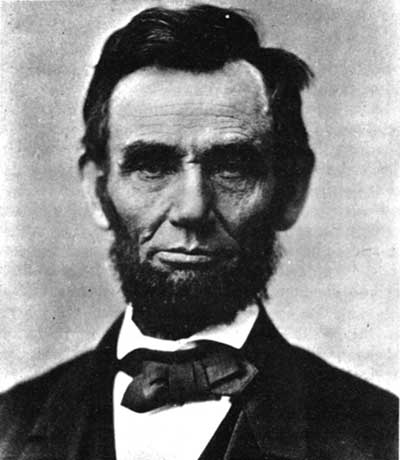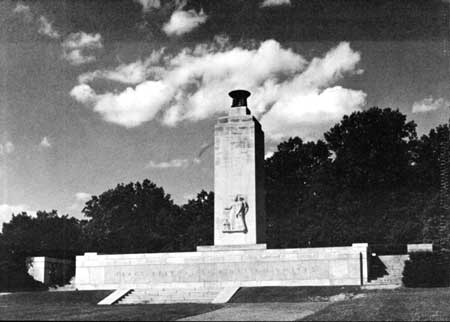|
GETTYSBURG National Military Park |
 |

The Alexander Gardner portrait of Lincoln, taken 4
days before the Gettysburg Address.
Meserve Collection.
Lincoln and Gettysburg
ESTABLISHMENT OF A BURIAL GROUND. For the residents of Gettysburg the aftermath of battle was almost as trying as the 3 days of struggle that had swirled about them. The town's 2,400 inhabitants, and the nearby country folk, bore a heavy share of the burden of caring for the 21,000 wounded and dying of both sides, who were left behind when the armies moved on. Spacious rooms in churches and schools and hundreds of homes were turned over to the care of the wounded; and kindly folk from neighboring towns came to help those of Gettysburg in ministering to the needs of the maimed and shattered men.
Adequate attention to the wounded was an immediate necessity, but fully as urgent was the need of caring for the dead. Nearly 6,000 had been killed in action, and hundreds died each day from mortal wounds. In the earlier stages of the battle, soldiers of both armies performed the tasks of burying their fallen comrades, but the struggle had reached such large proportions and the scene of battle had so shifted that fallen men had come within enemy lines. Because of the emergencies of battle, therefore, hundreds of bodies had been left unburied or only partially covered. It was evident that the limited aid which could be offered by local authorities must be supported by a well-organized plan for disinterment of the dead from the temporary burial grounds on the field and reburial in a permanent place at Gettysburg or in home cemeteries.
A few days after the battle, the Governor of the Commonwealth, Hon. Andrew Curtin, visited the battlefield to offer assistance in caring for the wounded. When official duties required his return to Harrisburg, he appointed Attorney David Wills, of Gettysburg, to act as his special agent. At the time of his visit, the Governor was especially distressed by the condition of the dead, In response to the Governor's desire that the remains be brought together in a place set aside for the purpose, Mr. Wills selected land on the northern slope of Cemetery Hill and suggested that the State of Pennsylvania purchase the ground at once in order that interments could begin without delay. He proposed that contributions for the purpose of laying out and landscaping the grounds be asked from legislatures of the States whose soldiers had taken part in the battle.
Within 6 weeks, Mr. Wills had purchased 17 acres of ground on Cemetery Hill and engaged William Saunders, an eminent landscape gardener, to lay out the grounds in State lots, apportioned in size to the number of graves for the fallen of each State. Each of the Union States represented in the battle made contributions for planning and landscaping.
The reinterment of close to 3,500 Union dead was accomplished only after many months. Great care had been taken to identify the bodies on the field, and, at the time of reinterment, remains were readily identified by marked boards which had been placed at the field grave or by items found on the bodies. Even so, the names of 1,664 remained un known, 979 of whom were without identification either by name or by State. Within a year, appropriations from the States made possible the enclosure of the cemetery with a massive stone wall and an iron fence on the Baltimore Street front, imposing gateways of iron, headstones for the graves, and a keeper's lodge. Since the original burials, the total of Civil War interments has reached 3,706. Including those of later wars, the total number now is close to 5,000.

The Eternal Light Peace Memorial, dedicated on
the 75th anniversary of the battle, commemorates "Peace Eternal in a
Nation United."
Union Pacific Railroad photograph.
The removal of Confederate dead from the field burial plots was not undertaken until 7 years after the battle. During the years 1870-73, upon the initiative of the Ladies Memorial Associations of Richmond, Raleigh, Savannah, and Charleston, 3,320 bodies were disinterred and sent to cemeteries in those cities for reburial, 2,935 being interred in Hollywood Cemetery, Richmond. Seventy-three bodies were reburied in home cemeteries.
The Commonwealth of Pennsylvania incorporated the cemetery in March 1864. The cemetery "having been completed, and the care of it by Commissioners from so many states being burdensome and expensive," the Board of Commissioners, authorized by act of the General Assembly of Pennsylvania in 1868, recommended the transfer of the cemetery to the Federal Government. The Secretary of War accepted title to the cemetery for the United States Government on May 1, 1872.

|

|
|
Last Modified: Mon, Mar 4 2002 10:00:00 pm PDT |


